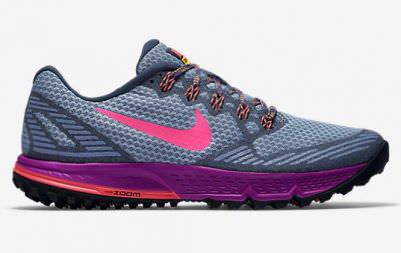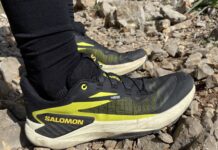
Nike is one of the most innovative running shoe brands out there. While they do stick to some popular models for years (ie the more than 30 years history of the Nike Pegasus), they constantly introduce new technologies and with them, new names and classification.
This article will help you make sense of all those model names, technical jargon and finally understand which of Nike’s running shoes is meant for which runner.
Click here if you want to jump straight to the shoes.
An overview of Nike running shoe upper technologies
Understanding the meaning and design principles behind the tech names will help you navigate through the catalog faster. Here’s an overview.
Flyknit
Flyknit is a special woven fabric that makes the upper of a shoe feel like a sock, by placing yarns and knits strategically around the structure in order to support the foot of the runner when needed and leave it free everywhere else.
Flyknit running shoes are lightweight: a light yarn replaces multiple stitched or glued panels. Flyknit also allows for extremely precise upper fit, being able to seamlessly integrate tight-knit areas where support is needed and wide-knit areas to allow for flexibility.
Flyknit is environmentally friendly as it produces 60% less waste than traditionally constructed running shoe uppers.
This technology is Nike’s latest, so expect to pay a premium for Flyknit shoes.
Most notable examples of Flyknit shoes are the Flyknit Racer (as the name implies, a fast and light shoe for racing distances all the way to the marathon) and the Nike Free Flyknit (an extremely flexible and lightweight running shoe to strengthen and train the muscles in your feet).
Engineered Mesh or Flymesh

Engineered Mesh features more prominent perforations than traditional mesh. It is a completely different construction than the previously mentioned Flyknit and shoes with Engineered Mesh usually have a lower price-point.
You’ll find Engineered Mesh on many of the Nike’s most popular running shoes. Notable ones are the Nike Zoom Pegasus, the Nike Zoom Structure and the Nike Lunarglide.
An overview of Nike running shoe midsole technologies
Midsoles of running shoes are made of foam. Each company has their own trademark foam mix that tries to achieve the following: be as lightweight as possible, be soft in order to absorb the impact with the ground, be elastic (in order to compress on impact and release propelling you forward), be durable (foam does deteriorate with use, so all foam materials need to be engineered to maintain its characteristics for a decent amount of time).
Nike Lunar Foam
In 2009, Nike introduced Lunarfoam, sometimes referred to as Lunarlon. Lunarlon is Nike’s softest, most cushioned and lightest foam compound.
Lunarlon is usually encapsuled in a container of harder Phylon foam in order to give structure and support to the foot where needed.
In short: choose Lunarfoam if you are looking for a soft, plush, cushioned ride.
Phylon
Phylon is Nike’s basic foam material. It is made of EVA Foam Pellets that are compressed then heat expanded & then finally cooled into a mold. It is easy to identify by the fine wrinkles the foam shows after usage.
Cushlon
Cushlon is a mix of Phylon and rubber additives that makes it lightweight and responsive.
Nike Air
Everybody knows Nike Air. That’s how Nike got big in the 80s in the first place. But do you exactly know what Nike Air is ?
Nike running shoes in the “Air” category often use Cushlon foam in their soles. Soft and resilient, this foam has 2 limitations: it is quite heavy (as most foam is) and it is not as “bouncy” as many runners expect their shoes to be.
The solution? Cutting off areas of the Cushlon-foam-made midsole and filling them up with plastic bags filled with “Air” (Nike’s secret gas compound). What this achieves is to reduce weight (by replacing the heavy foam with a very lightweight “airbag”) and to increase cushioning (being these airbags softer and springier than the Cushlon foam).
Depending on the shoe, you can have Nike Air bags in the heel, the toe, or both.
Air bags come in 3 formats: Air, Air Max and Zoom Air.
- Nike Air -> the most common, medium sized air bags that fit well especially under the heel.
- Air Max -> very thick and highly cushioned bags of air. In our opinion too unstable for proper running, mostly used on lifestyle shoes.
- Zoom Air -> the thinnest units, ideal to fit in low-profile shoes. They were initially developed for soccer shoes, where normal Air bags would not fit inside the ultra-thin sole
Nike Free
Nike Free is a concept. Started around 2005, the idea was to create a shoe that is so flexible that leaves the foot completely free to move in the most natural way.
Some people object that the Frees are still very cushioned shoes, therefore preventing the runner to have a true feeling for the ground below them.
While this might be true, the extreme flexibility of the Free sole unit, combined with very open-mesh and unconstrained upper make for a treat.
What do the numbers next to a Free shoe mean?
Nike abandoned the use of numbers in the Nike Free line in 2016, when they completely revamped the category.
Originally Nike Frees came in different versions, depending on how flexible they were. Their flexibility was ranked on a scale that goes from 1.0 to 10.0, where 1.0 means “bare feet” and 10.0 is a traditional running shoe.
In 2016, with the coming of the new auxetic construction, the Nike Free range is completely new and the numbers are gone. We’ll go through the line and the models in a minute. Keep reading!

Nike Free Auxetic Construction
The new principle behind the Nike FREE line of running shoes is called “auxetic design”.
When your foot hits the ground, it expands both in length and width. Picture bouncing a ball on the floor: it squeezes and deforms because of the impact, then the opposite happens while it bounces back.
Nike engineers were looking for a way to design a midsole so that it would expand in both directions during the foot strike. The issue is that most materials, when stretched in one direction, become smaller in the perpendicular direction. Again think of an elastic band. If you pull it to stretch it long, it will most likely become narrower in the middle.
The auxetic design, characterized by the triangular cuts you see in the picture, allows the sole to do that. A stretch in one direction will equate to a stretch in the other.
3 categories of Nike shoes for 3 kind of runs
(image credit: Nike.com/running)
After an admittedly quite long preamble about Nike’s tech, let’s finally talk about shoes.
Scientists, podiatrists, runners and shoe companies are slowly but surely moving away from categorizing their shoes solely based on the degree of pronation support they offer.
Nike is now categorizing their shoes based on the type of run the athlete wants to achieve. The guiding principle is “every run has a purpose”. Some runners want to run at a leisurely pace, maybe high mileage and prefer a shoe that offers comfort, breath-ability and soft cushioning.
Some other runners might prefer running fast and the feeling they want is responsiveness and quick foot turnaround. Other runners instead might be working on improving their running technique and stride and might be looking for a shoe that allows their feet to move as naturally as possible.
Many runners will be all of these, during different runs and different stages of their training/racing calendar. It is not a matter of how their ankles roll during the gait – it is a matter of what kind of running they enjoy and what they are trying to achieve. Once that is clear, there will be shoes able to accommodate all kind of over-pronation issues in each of the categories.
Enter the three categories:
Run Easy
Shoes in the Run Easy category focus on soft cushioning and premium uppers for a shoe that delivers comfort. Possibly for high mileage and cruise speed.
Nike running shoes in this category will more often than not feature Lunarlon midsole material – as we saw, the softest in the Nike arsenal. Uppers will be mostly Flyknit – as it’s Nike’s premium.
Nike LunarEpic Flyknit

$175 – LunarEpic Flyknit is the peak of Nike running shoe engineering in 2016. Unconventional looking, its sole unit is entirely made of Lunarlon that has been laser-cut both on the sides to collapse on impact and pressure-mapped Lunarlon pods on the bottom to absorb the impact and ditributing it evenly across the foot. The upper is a midcut entirely made of Flyknit.
Nike Lunarglide 7

$125 – The Nike LunarGlide 7 is aimed for those runners looking for a lightweight shoe that offers a reliable combination of stability and cushioning to assist with overpronation. A newly engineered mesh and “Flyknit” upper combined with the exceptional Lunarlon midsole foam introduced in the previous model, the LunarGlide 7 offers a secure, personalized fit all while delivering a smooth and responsive transition throughout a runner’s gait.
Nike Zoom Vomero 11

$140 – The Zoom Vomero 11 uses Lunarlon in the midsole to deliver soft cushioning. Zoom Air units are both in the heel and the forefoot. It is possibly Nike’s most cushioned running shoe. Ideal for logging long miles.
Nike Lunar Tempo 2

$100 – The Nike Lunar Tempo is a lightweight neutral trainer designed with a soft, cushioned ride in mind while keeping the weight quite low. The shoe adds a small amount of rubber compared to the previous model on the sole which gives a small amount of extra durability.
Run Fast
Shoes in the Run Fast category focus on a lock-in feel throughout the shoe and a cushioning that is responsive and returns energy rapidly.
Shoes in this category will predominantly feature Phylon or Cushlon midsoles with Zoom Air units to shed weight and provide a quick rebounce of the foot.
Nike Zoom Elite 8

$115 – The Air Zoom Elite is a lightweight, responsive shoe that doubles up as a high mileage trainer and racer. It features a Phylon midsole with Zoom Air on the forefoot, engineered mesh upper with asymmetrical lacing.
Nike Zoom Pegasus 33

$110 – The Pegasus 33 is the bread and butter of the Nike running shoe range. It is one of the shoes we recommend the most especially to beginners because of how balanced it is. Soft cushlon midsole with two Zoom units (heel and forefoot) it’s a perfect everyday workhorse.
Nike Zoom Structure 19

$120 – The Zoom Structure 19 is very similar to the Pegasus, but with added stability and support for overpronation thanks to the triple density midsole. The Structure is one of my all time favorite running shoes: responsive and comfortable with a substantial amount of support.
Run Natural
Run Natural is the category for shoes meant to mimic natural running. Lightweight, flexible and unobtrusive – these shoes are all part of the Nike FREE range.
Nike Free RN Motion Flyknit

$150 – The RN Motion Flyknit is the top of the range of the FREE line. The auxetic construction in the Motion Flyknit is the most prominent, providing the most natural run that the FREE lineup has offered to date. It is completed by a Flyknit upper and reinforced by Flywire cables tightened through the laces. It is the heir of the Nike Free 3.0
Nike Free RN Flyknit

$130 – The Free RN Flyknit is the successor of the Nike Free 4.0 – a shoe that is slightly more constructed than the Motion version. Upper is still the high-quality Flyknit with Flywire combination that combines flexibility with structure.
Nike Free RN

$100 – Free RN replaces the Nike FREE 5.0 in the Natural line of Nike running shoes. Still utilizing the auxetic construction for the sole unit, the upper is Egineered Mesh with Flywire cables. Compared to the Free 5.0 – the midsole material used in the Free RN is softer.
Nike Free RN Distance

$120 – Nike Free RN Distance is a shoe made for comfort during long runs while still letting you experience the natural motion feeling. The sole is made of Lunarlon foam wrapped in a Phylon carrier to blend plush cushioning and durability. Launched in 2015, the Free RN Distance does not fully utilize the auxetic construction, but replaced the traditional square pods of Nike Free shoes with hexagons.
Nike Racing running shoes
In addition to the three categories we saw above, the Nike lineup also offers Racing and Trail shoes. Here are the racers:
Nike Flyknit Racer

$150 – Launched in 2013 and back in 2016 due to popular demand, the Flyknit Racer is an extremely lightweight racing shoe with a Phylon midsole with forefoot Zoom Air. Completed by an all-Flyknit upper, it is Nike’s top marathon racing shoe.
Nike Lunaracer+ 3

$110 – The Lunaracer is a racing shoe for distances from 5k to the marathon. Its most interesting characteristic is the very low weigth for a shoe that is soft and supportive.
Nike Zoom Streak LT 3

$80 – The lightest shoe of the category, the Streak LT is a shoe for any race from hard surfaces to cross country.
Nike Trail running shoes
Last, the selection of Trail shoes. To keep it simple, there are only two:
Nike Air Zoom Wildhorse 3

$110 – The Wildhorse is the trail shoe with ultra-marathons in mind. With a 8mm offset and 11 ounces of weight, it features a rock plate, aggressive lugs and a very sturdy upper material.
Nike Zoom Terra Kiger 3

$125 – The Terra Kiger is lighter and with a lower offset (4mm) than the Wildhorse. It offers a more responsive contact with the ground and does NOT feature a rock plate.
Did you find this overview useful? Then don’t forget to share it on your favorite social network. Took me FOREVER to write it and I would love it if as many people as possible could read it.
Don’t forget to have a look at the other brand guides we wrote this year:
































